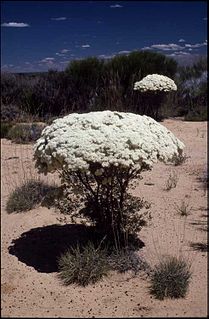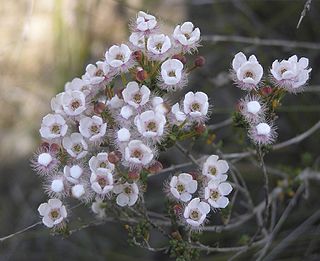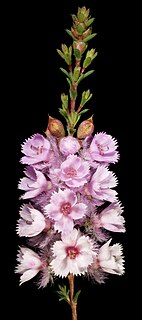
Verticordia insignis is a species of flowering plant in the myrtle family, Myrtaceae and is endemic to the south-west of Western Australia. It is an open, irregularly-branched shrub with small leaves and heads of relatively large pink, or white and pink flowers on the ends of the branches in spring.

Verticordia brownii, commonly known as pink brownii or pink cauliflower is a flowering plant in the myrtle family, Myrtaceae, and is endemic to the south-west of Western Australia. It has small, neatly arranged, oval leaves and heads of pale pink to magenta or white flowers. It was one of the first verticordias to be collected, although it was not initially known by that name. The collection was made by Robert Brown on the Bass and Flinders circumnavigation of the Australian mainland on HMS Investigator.
Verticordia brachypoda is a flowering plant in the myrtle family, Myrtaceae and is endemic to the south-west of Western Australia. It is an irregularly branched shrub with narrow leaves crowded on side-branches, and cream-coloured or white flowers with pink, cream or white centres.
Verticordia capillaris is a flowering plant in the myrtle family, Myrtaceae and is endemic to the south-west of Western Australia. It is a shrub with a single stem at the base, small leaves and creamy white or occasionally pink flowers in dense corymb-like groups. It is common in small areas near Geraldton.

Verticordia subulata is a flowering plant in the myrtle family, Myrtaceae and is endemic to the south-west of Western Australia. It is a woody shrub with pointed, linear leaves and in spring, heads of yellow flowers which turn red as they age.

Verticordia habrantha, commonly known as hidden featherflower, is a flowering plant in the myrtle family, Myrtaceae and is endemic to the south-west of Western Australia. It is a slender shrub with short, leafy side-branches and long flowering stems with rounded heads of mostly white flowers. Its hairy sepals are mostly hidden by the round, unfringed petals, and as a result, the plant looks like shrubs in the genus Chamelaucium, to which it is closely related.

Verticordia pennigera, commonly known as native tea, is a flowering plant in the myrtle family, Myrtaceae, and is endemic to the south-west of Western Australia. It is usually a small erect or prostrate shrub with small leaves and lightly-scented spikes of pale pink to magenta-coloured flowers in spring.

Verticordia halophila, commonly known as salt-loving featherflower, or salt-loving verticordia, is a flowering plant in the myrtle family, Myrtaceae and is endemic to the south-west of Western Australia. It is an erect, bushy shrub with small, crowded, thick leaves and spikes of red and pink flowers in spring.

Verticordia pritzelii, commonly known as Pritzel's featherflower, is a flowering plant in the myrtle family, Myrtaceae and is endemic to the south-west of Western Australia. It is a compact, woody shrub with several main stems, small, linear to club-shaped leaves, and rounded groups of deep pink flowers from late spring to mid-summer.
Verticordia centipeda is a flowering plant in the myrtle family, Myrtaceae and is endemic to the south-west of Western Australia. It is a shrub with a single stem at the base, small crowded leaves and greenish-pink flowers with a silvery fringe, in spike-like groups on the ends of the branches. It is common in areas around Geraldton.
Verticordia densiflora var. cespitosa is a flowering plant in the myrtle family, Myrtaceae and is endemic to the south-west of Western Australia. It is a shrub with small leaves and pink, or pink and white flowers. It is one of five varieties of the species Verticordia densiflora.

Verticordia grandiflora, commonly known as claw featherflower, clawed featherflower or horned featherflower, is a flowering plant in the myrtle family Myrtaceae, and is endemic to the south-west of Western Australia. It is a small, rigid shrub with many short side-branches, mostly linear leaves and heads of yellow flowers which soon age to reddish but which are among the largest in the genus. It is similar in appearance to several other species of verticordias with which it is often confused.
Verticordia helmsii is a flowering plant in the myrtle family, Myrtaceae and is endemic to the south-west of Western Australia. It is a shrub with most of its leaves clustered on short side branches and with small groups of scented creamish-white flowers in small groups along the branches.

Verticordia humilis, commonly known as small featherflower, is a flowering plant in the myrtle family, Myrtaceae and is endemic to the south-west of Western Australia. It is a small shrub with leafy branches and scattered, mostly red flowers hanging loosely near the ends of the branches.
Verticordia integra, commonly known as plastic verticordia, is a flowering plant in the myrtle family, Myrtaceae and is endemic to the south-west of Western Australia. It is a shrub with only a few branches, with very thick oblong to egg-shaped leaves and heads of shiny golden-coloured flowers in late spring.
Verticordia minutiflora is a flowering plant in the myrtle family, Myrtaceae and is endemic to the south-west of Western Australia. It is a bushy shrub with small, crowded, cylindrical leaves and groups of white to pale pink flowers in summer and autumn. As suggested by its botanical name, it has the smallest flowers of any verticordia.
Verticordia rennieana is a flowering plant in the myrtle family, Myrtaceae and is endemic to the south-west of Western Australia. It is an openly branched shrub with small, narrow, warty leaves and pink and silvery-white flowers in spring and summer.

Verticordia roei, commonly known as Roe's featherflower is a flowering plant in the myrtle family, Myrtaceae and is endemic to the south-west of Western Australia. It is a shrub with narrow leaves and is often covered with masses of creamy-white coloured flowers in late spring.
Verticordia sieberi is a flowering plant in the myrtle family, Myrtaceae and is endemic to the south-west of Western Australia. It is a shrub with one main stem, often compact but sometimes openly branched and with pink to pale purple flowers in summer and autumn.
Verticordia vicinella is a flowering plant in the myrtle family, Myrtaceae and is endemic to the south-west of Western Australia. It is a shrub with narrow leaves and groups of small, scented, pink or pale yellow flowers, growing near Esperance and in the Cape Arid National Park.










